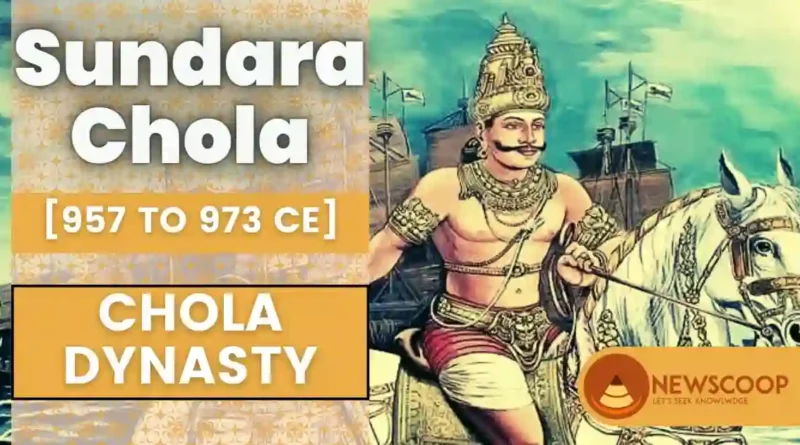Sundara Chola (957 to 973 CE): Parantaka Chola II | Sons, Wife & Father
Parantaka Chola II, also known as Sundara Chola, was the son of Arinjaya Chola and ascended to the Chola throne despite the potential challenge of his cousin Uttama Chola. His reign lasted for approximately twelve years, during which he expanded the Chola Empire through military campaigns and patronized Tamil literature and the arts.
| Ruler | Sundara Chola |
| Also known as | Parantaka Chola II |
| Father | Arinjaya Chola |
| Mother | Kalyani |
| Time Period | 957 – 973 CE |
| Dynasty | Chola Dynasty |
Who was Sundara Chola?
Parantaka Chola II, also known as Sundara Chola, was a ruler of the Chola Dynasty who reigned for approximately twelve years from 957 to 973 CE. He was the son of Arinjaya Chola and his mother, Kalyani, was a Vaidumbas princess. Despite the fact that Uttama Chola, the son of Arinjaya’s elder brother Gandaraditya, had an equal or even greater claim to the Chola throne, Parantaka II was the one who ascended to the throne.
During his reign, Parantaka II embarked on several military campaigns to expand the Chola Empire’s territory. He successfully conquered the Chera, Pandya, and Kongu regions, as well as parts of Sri Lanka.
In addition to his military conquests, Parantaka II was also a patron of the arts and literature. He was a prolific writer and poet himself, and he commissioned several works of art and literature during his reign.
One of the most significant events of Parantaka II’s reign was his successful defense of the Chola Empire against the Western Chalukya Empire.
The Chalukyas, under their king Tailapa II, invaded the Chola Empire, but Parantaka II was able to repel their attack and maintain his kingdom’s independence. His military prowess and successful defense against the Chalukyas earned him the title of “Chalukya Chakravarti” which means “Emperor of the Chalukyas.”
History of Sundara Chola
- Sundara Chola, an emperor of the Chola dynasty, earned the nickname “Sundara Chola” due to his reputed exceptional physical appearance, which was regarded as the epitome of masculine beauty.
- Sundara Chola was born to Arinjaya Chola and Kalyani, a princess belonging to the Vaidumba dynasty of Andhra, which was centered around the districts of Kurnool and Kadapa.
- Although his cousin Uttama Chola, the son of Gandaraditya (the elder brother of Arinjaya Chola), was alive and had an equal or even stronger claim to the Chola throne, Parantaka II managed to ascend to the throne.
- At the time Parantaka II became the king, the Chola kingdom had diminished to a small principality as the Pandyas in the south had regained strength and defeated the Chola armies, recapturing their original territories.
- Parantaka II initiated some measures during his reign that paved the way for the remarkable success of the Chola Empire in the following generation. One such measure was the reclamation of a few territories in the northern parts.
- Under his reign, the Cholas achieved significant military success by defeating Vira Pandya, the Pandyan ruler, and capturing the city of Madurai. Although an expedition was launched to conquer Sri Lanka, it was not successful.
Battle of Chevur
The Battle of Chevur indeed refers to the conflict between the Cholas and the Pandyas in Chevur. Vira Pandya was the ruler of the Pandyan empire when Parantaka Chola II became king. Parantaka II, desiring to invade Pandyan territory, appointed his son Aditya II (also known as Aditya Karikalan) to lead an army battalion.
The armies of the Cholas and Pandyas clashed at Chevur, and according to the Leyden copper plate inscription and other inscriptions, Parantaka II caused great bloodshed during the battle. Aditya II played a significant role in the victory, and it is mentioned in an inscription that he took Vira Pandyan’s head, earning him the epithet “Vira Pandyan Thalai Konda Adithha Karikalan.”
Following the Battle of Chevur, Parantaka II went on to annex more parts of the Pandyan empire. It is mentioned that at the time, the Sri Lankan King Mahinda IV was an ally of the Pandyan empire. As a result, Parantaka II also invaded the Lankan empire, but the consequences of this invasion are not explicitly mentioned.
While Parantaka II attempted to capture the entire Pandyan empire, he was ultimately unsuccessful in his endeavor. The outcome of his invasion and the subsequent events are not detailed in the information you provided. It’s worth noting that historical events can be complex, and additional sources may provide more comprehensive accounts of the specific details and outcomes of these conflicts.
Conclusion
After Aditya II was assassinated, Uttama Chola, a Chola ruler, exerted pressure on Parantaka II to name him as the heir apparent. However, according to the Thiruvalangadu copper plate inscription, Madhurantaka Uttama Chola appointed Arulmoli as his heir apparent.
Sundara Chola died in Kanchipuram, in his golden palace, after suffering a personal tragedy, earning him the posthumous title “Pon maligai thunjina thevar” or “the king who died in the golden palace.”
Thank You!
Who was Sundara Chola?
Parantaka Chola II, also known as Sundara Chola, was a notable ruler of the Chola Dynasty, reigning for around twelve years from 957 to 973 CE.
Who was the father of Sundara Chola?
He was the son of Arinjaya Chola and his mother, Kalyani, was a Vaidumbas princess.
What were some of the major achievements of Parantaka Chola II?
Parantaka Chola II’s major achievements include military successes against the Pandyas, administrative reforms, patronage of arts and literature, promotion of Shaivism, and the construction of iconic temples. He expanded Chola territory, improved governance, supported cultural development, and contributed to the religious and architectural legacy of the empire.
Related Links:

